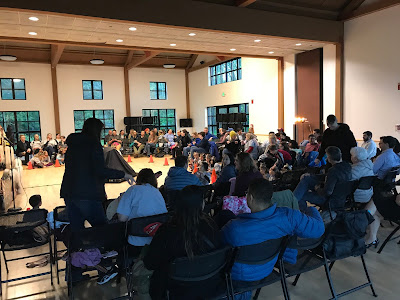Practicing our Deer and Wolf Dance for the evening potlatch.
In a classroom of brilliant, engaged, eager students, it's often difficult to hear, let alone listen. This was the first of four important skills that Ronn "Long Claw" Wilson, a First Native of the North Vancouver Island Kwakwala Clan, taught us. He called it haboo.
"Skills must be taught, learned, and practiced."
He welcomed us into the beautiful outdoor "living room" of the animals and plants and encouraged us to use our manners. Click here to hear his clan's welcome song.
We played games.
We made headbands and masks in the Northwest Coast line drawing style.
We touched furs.
We carefully touched a porcupine fur.
We looked for the softest fur of all, a small little bat.
The middle schoolers explained
the significance of the Museum Display.
"Smell the basket."
"Touch the hooves."
"Look at the Cedar tree carved masks."
This mask opened up.
The second graders made Northern Orca headdresses.
The first graders made Southern Orca headdresses and masks.
In the evening our Seabury School family and friends gathered together for a potlatch.
The middle school students took on prominent roles--drumming on a long drum, dancing the canoe dance, and welcoming Sasquatch to the ceremony. See their blog here.
The wolf and deer dancers!
One first grader says what we felt best!
Thank you, Ronn Wilson from "Of Cedar and Salmon," for bringing history to life, immersing the Navigators into the culture of early Pacific Northwest peoples. We have become better people as a result.
Haboo? Haboo!




























































